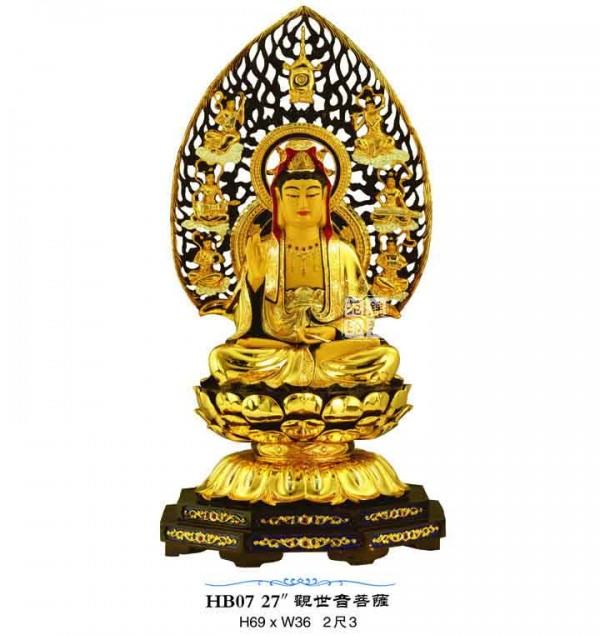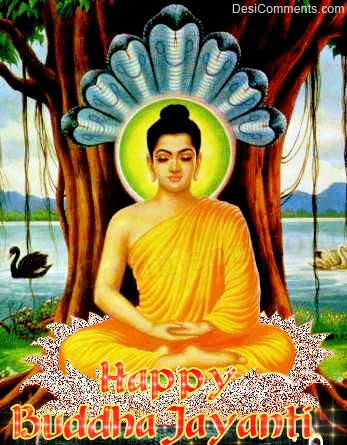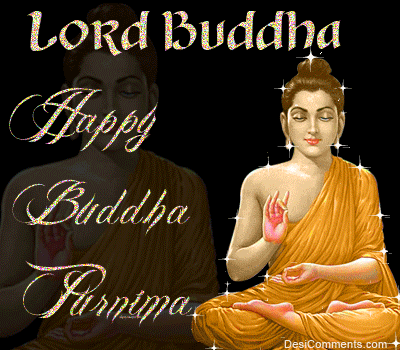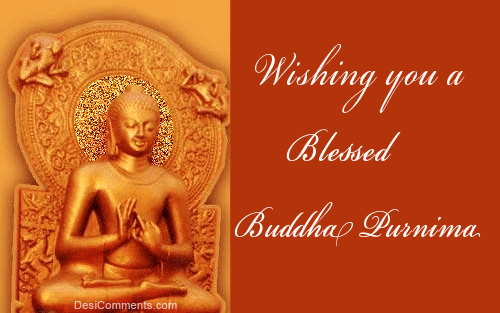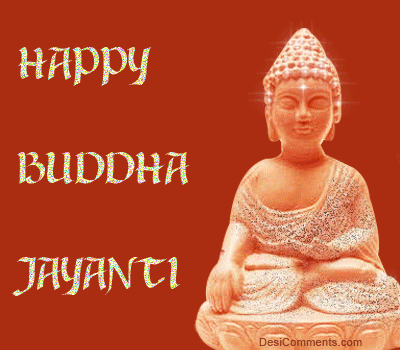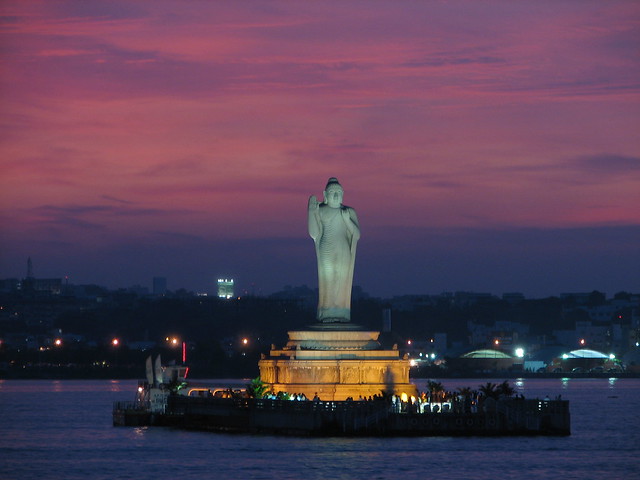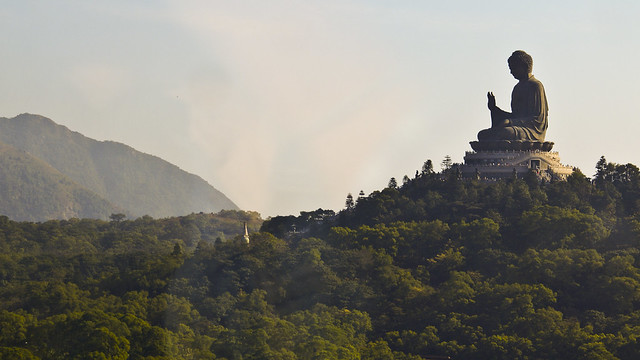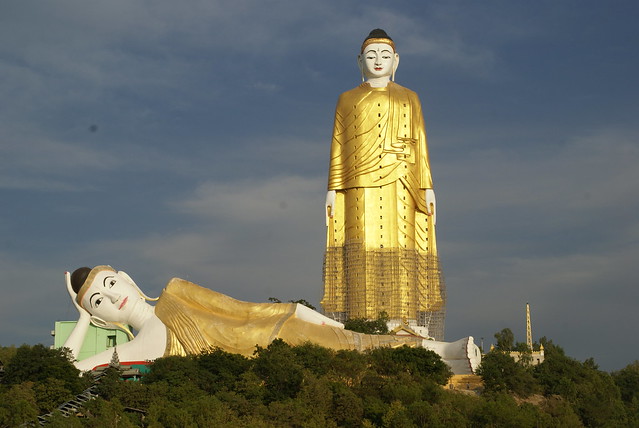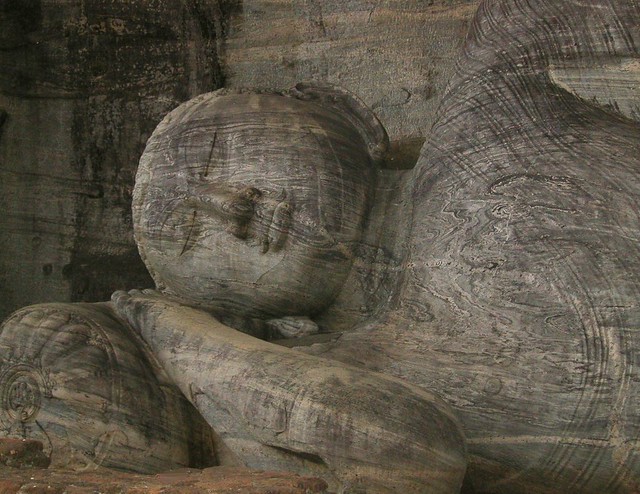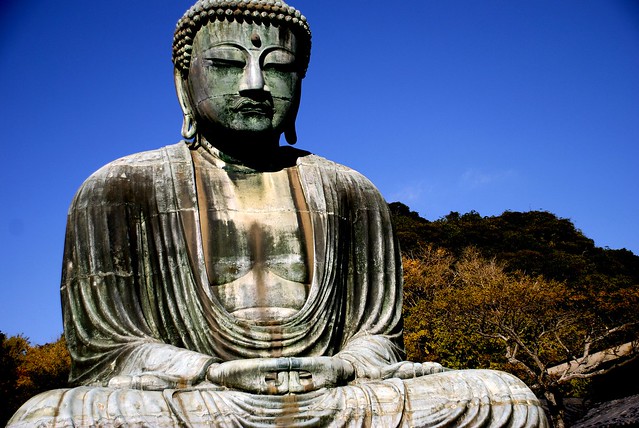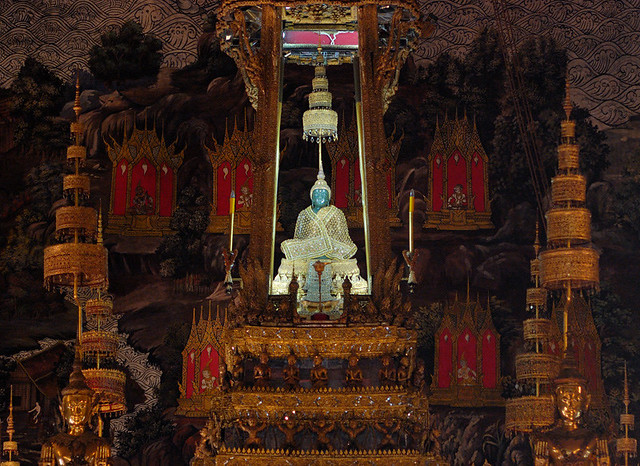Related Articles
New voter verifiable paper trail (VVPT) machines to replace the EVMs, following doubts that it could be tampered.Voting Machines are “Calculators which can be manipulated by computer softwares”. New Machines are ordered by EC, where a paper slip will come out with EVM voting which will be then deposited in a box. What is the use? Paper Slip will show that voter has casted vote for “Party A”, but calculator software will add vote to “Party B”! The Computers are programmable. No use for such fake paper slips. In Superior Courts it has been demonstrated how these computers can be manipulated and how it can be pre-programmed to make sure victory to one candidate during election. The EVM machines have killed Democracy and have all the potentials to do so. The ruling castes are manipulating EVMs to make sure victory to them depriving the dipressed classes to enable them to acquire the MASTER KEY that can unlock all doors of progress to the entire people.
•
• Under such circumstances the following exposure by media had no relevance during the last Karnataka Assembly Elections 2013 where the Congress won and the trend will continue in the forth coming General Elections until the Superior Court and the upholders of Democracy including the free and fair media.
6.1 The Case of Mandated Source Disclosure
There are risks and some benefits associated with government-mandated public disclosure using either a disclosed source regime or open source licenses. One such risk is that trade secrecy would be de facto eliminated from the highly competitive, small-margin voting systems market. A trade secret is defined as any secret information used in business that gives one a competitive advantage; trade secrecy protection only applies to information that is kept secret.61Vendors have asserted that their software contains trade secrets that would no longer be protectable if their software source were disclosed.62
The end of trade secrecy in software source code could mean the end for larger companies, which are more sensitive to the smallness of margins, as it will cause a slip of their market position and competitive edge against other larger vendors. If open source software is required, a body of open source software for election management and tabulation will be created that will lower the barriers to entry into the market and necessarily increase competition. The available software will be one piece that new firms will not need to develop in creating a viable voting system (see § for a discussion of other barriers to entry). Either of these possibilities will make it easier for small firms to enter the market, but also may make the market less appetizing for large vendors.
There could be narrower licensing options under a government mandate. That is, if a governmental entity deems it necessary to mandate disclosure, it would seem that they would also specify the terms of such disclosure. This would prohibit vendors from doing their own calculus of what to allow and disallow in the terms of their software license and would mean that they now had to fit their previous business models into the license agreement mandated for the market in which they seek to operate.
Finally, there is an evolving concept of eminent domain in the field of intellectual property, where the government must compensate an individual for taking property. The government “takings'’ here apply to situations where a vendor’s intellectual property is disclosed without their consent or approval. Should vendors be compensated for the release of intellectual property in the source code that runs their systems? The relevant forms of intellectual property implicated in the source code for voting systems are patents, copyright and trade secrets. Patents and copyrights are not much of an issue as both these forms of intellectual property will still be enforceable upon disclosure and there are statutory limits to damages.63 Claims under the Freedom of Information Act (FOIA) or its state-level equivalents will usually protect proprietary and confidential information.64
That leaves the case of trade secrets released against the vendor’s wishes. In Ruckelshaus v. Monsanto Co.,65 the Supreme Court found that the disclosure of trade secrets claimed to be held in confidence by the Environmental Protection Agency (EPA) as part of a pesticide registration program was a 5th amendment “taking'’ of property.66The Court ruled that the “taking'’ existed when Monsanto had a “reasonable investment-backed expectation'’ of confidentiality and that this was formed when the EPA allowed vendors to mark certain information as trade secret through their registration program.67Further, without a reasonable investment-backed expectation, no taking existed. A key feature of the Ruckelshaus notion of “takings'’ is its retroactive nature; that is, the analysis turns on the expectation of confidentiality that the vendor had when submitting information to the government.
For voting systems, this means that any disclosure should be done carefully. That is, with rules or laws that mandate disclosure, any efforts to extend the effects of such policy to source code submissions made under a previous regime would likely run afoul of the Ruckelshaus notion of 5th Amendment “taking'’ of trade secrets. Voting systems vendors will likely not find it difficult to make a showing of “reasonable investment-backed expectation'’, as past indications show that vendors have been highly protective of their intellectual property.68From this analysis, the best course of action would be a non-retroactive policy in which the government clearly stated its intent to disclose system source code and also stipulated that any trade secrets would have to be removed by the vendor prior to submission.
(Suddhapàcittiyà)
Ime kho panàyasmanto dvenavuti pàcittiyà dhammà uddesaü àgacchanti.
[BJT Vol II (I), Page 004] [\x 004/]
Pàc 1: Musàvàdasikkhàpadaü:
Sampajànamusàvàde, pàcittiyaü.
[BJT Vol II (I), Page 016] [\x 016/]
Pàc 2: Omasavàdasikkhàpadaü:
Omasavàde, pàcittiyaü.
[BJT Vol II (I), Page 042] [\x 042/]
Pàc 3: Pesu¤¤asikkhàpadaü:
Bhikkhupesu¤¤e, pàcittiyaü.
[BJT Vol II (I), Page 052] [\x 052/]
Pàc 4: Padasodhammasikkhàpadaü:
Yo pana bhikkhu anupasampannaü padaso dhammaü vàceyya, pàcittiyaü.
[BJT Vol II (I), Page 058] [\x 058/]
Pàc 5: Sahaseyyasikkhàpadaü:
Yo pana bhikkhu anupasampannena uttariü 15 dirattatirattaü sahaseyyaü kappeyya, pàcittiyaü.
[BJT Vol II (I), Page 064] [\x 064/]
Pàc 6: Dutiyasahaseyyasikkhàpadaü:
Yo pana bhikkhu màtugàmena sahaseyyaü kappeyya, pàcittiyaü.
[BJT Vol II (I), Page 068] [\x 068/]
Pàc 7: Dhammadesanàsikkhàpadaü:
Yo pana bhikkhu màtugàmassa uttariü chappa¤cavàcàhi dhammaü deseyya, a¤¤atra vi¤¤unà purisaviggahena, pàcittiyaü.
[BJT Vol II (I), Page 078] [\x 078/]
Pàc 8: Bhåtàrocanasikkhàpadaü:
Yo pana bhikkhu anupasampannassa uttarimanussadhammaü àroceyya bhåtasmiü, pàcittiyaü.
[BJT Vol II (I), Page 098] [\x 098/]
Pàc 9: Duññhullàrocanasikkhàpadaü:
Yo pana bhikkhu bhikkhussa duññhullaü àpattiü anupasampannassa àroceyya, a¤¤atra bhikkhusammutiyà, pàcittiyaü.
[BJT Vol II (I), Page 102] [\x 102/]
Pàc 10: Pathavikhaõanasikkhàpadaü:
Yo pana bhikkhu pañhaviü khaõeyya và khaõàpeyya và, pàcittiyaü.
Musàvàdàvaggo pañhamo
[BJT Vol II (I), Page 106] [\x 106/]
Pàc 11: Bhåtagàmasikkhàpadaü:
Bhåtagàmapàtavyatàya, pàcittiyaü.
[BJT Vol II (I), Page 112] [\x 112/]
Pàc 12: A¤¤avàdakasikkhàpadaü:
A¤¤avàdake vihesake, pàcittiyaü.
[BJT Vol II (I), Page 118] [\x 118/]
Pàc 13: Ujjhàyanasikkhàpadaü:
Ujjhàpanake khãyanake, pàcittiyaü.
[BJT Vol II (I), Page 120] [\x 120/]
Pàc 14: Pañhamasenàsanasikkhàpadaü:
Yo pana bhikkhu saïghikaü ma¤caü và
pãñhaü và bhisiü và kocchaü và ajjhokàse santharitvà và santharàpetvà
và, taü pakkamanto neva uddhareyya na uddharàpeyya, anàpucchaü và
gaccheyya, pàcittiyaü.
[BJT Vol II (I), Page 124] [\x 124/]
Pàc 15: Dutiyasenàsanasikkhàpadaü:
Yo pana bhikkhu saïghike vihàre seyyaü
santharitvà và santharàpetvà và, taü pakkamanto neva uddhareyya na
uddharàpeyya, anàpucchaü và gaccheyya, pàcittiyaü.
[BJT Vol II (I), Page 128] [\x 128/]
Pàc 16: Anupakhajjasikkhàpadaü:
Yo pana bhikkhu saïghike vihàre jànaü
pubbåpagataü bhikkhuü anupakhajja seyyaü kappeyya: ßYassa sambàdho
bhavissati, so pakkamissatãû-ti. Etad-eva paccayaü karitvà ana¤¤aü,
pàcittiyaü.
[BJT Vol II (I), Page 132] [\x 132/]
Pàc 17: Nikkaóóhanasikkhàpadaü:
Yo pana bhikkhu bhikkhuü kupito anattamano saïghikà vihàrà nikkaóóheyya và nikkaóóhàpeyya và, pàcittiyaü.
[BJT Vol II (I), Page 136] [\x 136/]
Pàc 18: Vehàsakåñisikkhàpadaü:
Yo pana bhikkhu saïghike vihàre
uparivehàsakuñiyà àhaccapàdakaü ma¤caü và pãñhaü và abhinisãdeyya và
abhinipajjeyya và, pàcittiyaü.
[BJT Vol II (I), Page 140] [\x 140/]
Pàc 19: Mahallakavihàrasikkhàpadaü:
Mahallakaü pana bhikkhunà vihàraü
kàrayamànena, yàva dvàrakosà aggalaññhapanàya àlokasandhiparikammàya
dvatticchadanassa pariyàyaü, appaharite ñhitena adhiññhàtabbaü. Tato ce
uttariü appaharite pi ñhito adhiññhaheyya, pàcittiyaü.
[BJT Vol II (I), Page 142] [\x 142/]
Pàc 20: Sappàõasikkhàpadaü:
Yo pana bhikkhu jànaü sappàõakaü udakaü tiõaü và mattikaü và si¤ceyya và si¤càpeyya và, pàcittiyaü.
Bhåtagàmavaggo dutiyo
[BJT Vol II (I), Page 148] [\x 148/]
Pàc 21: Ovàdasikkhàpadaü:
Yo pana bhikkhu asammato bhikkhuniyo ovadeyya, pàcittiyaü.
[BJT Vol II (I), Page 160] [\x 160/]
Pàc 22: Atthaïgatasikkhàpadaü:
Sammato pi ce bhikkhu atthaïgate suriye bhikkhuniyo ovadeyya, pàcittiyaü.
[BJT Vol II (I), Page ] [\x /]
Pàc 23: Bhikkhunåpassayasikkhàpadaü:
Yo pana bhikkhu bhikkhunåpassayaü upsaïkamitvà bhikkhuniyo ovadeyya, a¤¤atra samayà, pàcittiyaü.
Tatthàyaü samayo: gilànà hoti bhikkhunã - ayaü tattha samayo.
[BJT Vol II (I), Page 168] [\x 168/]
Pàc 24: âmisasikkhàpadaü:
Yo pana bhikkhu evaü vadeyya: ßâmisahetu bhikkhå 16 bhikkhuniyo ovadantãû-ti, pàcittiyaü.
[BJT Vol II (I), Page 174] [\x 174/]
Pàc 25: Cãvaradànasikkhàpadaü:
Yo pana bhikkhu a¤¤àtikàya bhikkhuniyà cãvaraü dadeyya, a¤¤atra pàrivaññakà, pàcittiyaü.
[BJT Vol II (I), Page 178] [\x 178/]
Pàc 26: Cãvarasibbanasikkhàpadaü:
Yo pana bhikkhu a¤¤àtikàya bhikkhuniyà cãvaraü sibbeyya và sibbàpeyya và, pàcittiyaü.
[BJT Vol II (I), Page ] [\x /]
Pàc 27: Saüvidhànasikkhàpadaü:
Yo pana bhikkhu 17 bhikkhuniyà saddhiü saüvidhàya ekaddhànamaggaü pañipajjeyya antamaso gàmantaram-pi, a¤¤atra samayà, pàcittiyaü.
Tatthàyaü samayo: satthagamanãyo hoti maggo sàsaïkasammato sappañibhayo - ayaü tattha samayo.
[BJT Vol II (I), Page 186] [\x 186/]
Pàc 28: Nàvàbhiråhatasikkhàpadaü:
Yo pana bhikkhu bhikkhuniyà saddhiü saüvidhàya ekaü nàvaü abhiråheyya uddhagàminiü 18 và adhogàminiü và, a¤¤atra tiriyaü taraõàya, pàcittiyaü.
[BJT Vol II (I), Page 192] [\x 192/]
Pàc 29: Paripàcitasikkhàpadaü:
Yo pana bhikkhu jànaü bhikkhunãparipàcitaü piõóapàtaü bhu¤jeyya, a¤¤atra pubbe gihãsamàrambhà, pàcittiyaü.
[BJT Vol II (I), Page 196] [\x 196/]
Pàc 30: Rahonisajjasikkhàpadaü:
Yo pana bhikkhu bhikkhuniyà saddhiü eko ekàya raho nisajjaü kappeyya, pàcittiyaü.
Bhikkhunovàdavaggo tatiyo
[BJT Vol II (I), Page 202] [\x 202/]
Pàc 31: âvasathapiõóasikkhàpadaü:
Agilànena bhikkhunà eko àvasathapiõóo bhu¤jitabbo. Tato ce uttariü bhu¤jeyya, pàcittiyaü.
[BJT Vol II (I), Page 210] [\x 210/]
Pàc 32: Gaõabhojanasikkhàpadaü:
Gaõabhojane, a¤¤atra samayà, pàcittiyaü.
Tatthàyaü samayo: gilànasamayo, cãvaradànasamayo, cãvarakàrasamayo,
addhànagamanasamayo, nàvàbhiråhanasamayo, mahàsamayo, samaõabhattasamayo
- ayaü tattha samayo.
[BJT Vol II (I), Page 218] [\x 218/]
Pàc 33: Paramparabhojanasikkhàpadaü:
Paramparabhojane, a¤¤atra samayà, pàcittiyaü.
Tatthàyaü samayo: gilànasamayo, cãvaradànasamayo, cãvarakàrasamayo - ayaü tattha samayo.
[BJT Vol II (I), Page 224] [\x 224/]
Pàc 34: Kàõamàtusikkhàpadaü:
Bhikkhuü paneva kulaü upagataü påvehi
và manthehi và abhihaññhuü pavàreyya. âkaïkhamànena bhikkhunà
dvattipattapårà pañiggahetabbà. Tato ce uttariü pañiggaõheyya,
pàcittiyaü.
Dvattipattapåre pañiggahetvà tato nãharitvà bhikkhåhi saddhiü saüvibhajitabbaü. Ayaü tattha sàmãci.
[BJT Vol II (I), Page 230] [\x 230/]
Pàc 35: Pañhamapavàraõasikkhàpadaü:
Yo pana bhikkhu bhuttàvã pavàrito anatirittaü, khàdanãyaü và bhojanãyaü và khàdeyya và bhu¤jeyya và, pàcittiyaü.
[BJT Vol II (I), Page 234] [\x 234/]
Pàc 36: Dutiyapavàraõasikkhàpadaü:
Yo pana bhikkhu bhikkhuü bhuttàviü
pavàritaü anatirittena khàdanãyena và bhojanãyena và abhihaññhuü
pavàreyya: ßHanda bhikkhu khàda và bhu¤ja vàû-ti, jànaü àsàdanàpekkho,
bhuttasmiü, pàcittiyaü.
[BJT Vol II (I), Page 238] [\x 238/]
Pàc 37: Vikàlabhojanasikkhàpadaü:
Yo pana bhikkhu vikàle khàdanãyaü và bhojanãyaü và khàdeyya và bhu¤jeyya và, pàcittiyaü.
[BJT Vol II (I), Page 242] [\x 242/]
Pàc 38: Sannidhikàrasikkhàpadaü:
Yo pana bhikkhu 19 sannidhikàrakaü khàdanãyaü và bhojanãyaü và khàdeyya và bhu¤jeyya và, pàcittiyaü.
[BJT Vol II (I), Page 246] [\x 246/]
Pàc 39: Paõãtabhojanasikkhàpadaü:
Yàni kho pana tàni paõãtabhojanàni,
seyyathãdaü: sappi, navanãtaü, telaü, madhu, phàõitaü, maccho, maüsaü,
khãraü, dadhi. Yo pana bhikkhu evaråpàni paõãtabhojanàni agilàno attano
atthàya vi¤¤àpetvà bhu¤jeyya, pàcittiyaü.
[BJT Vol II (I), Page 250] [\x 250/]
Pàc 40: Dantaponasikkhàpadaü:
Yo pana bhikkhu adinnaü mukhadvàraü àhàraü àhareyya, a¤¤atra udakadantaponà, pàcittiyaü.
Bhojanavaggo catuttho
[BJT Vol II (I), Page 254] [\x 254/]
Pàc 41: Acelakasikkhàpadaü:
Yo pana bhikkhu acelakassa và paribbàjakassa và paribbàjikàya và sahatthà khàdanãyaü và bhojanãyaü và dadeyya, pàcittiyaü.
[BJT Vol II (I), Page 256] [\x 256/]
Pàc 42: Uyyojanasikkhàpadaü:
Yo pana bhikkhu bhikkhuü: ßEhàvuso
gàmaü và nigamaü và piõóàya pavisissàmàû-ti. Tassa dàpetvà và adàpetvà
và uyyojeyya: ßGacchàvuso na me tayà saddhiü kathà và nisajjà và phàsu
hoti, ekakassa me kathà và nisajjà và phàsu hotãû-ti. Etad-eva paccayaü
karitvà ana¤¤aü, pàcittiyaü.
[BJT Vol II (I), Page 260] [\x 260/]
Pàc 43: Sabhojanasikkhàpadaü:
Yo pana bhikkhu sabhojane kule anupakhajja nisajjaü kappeyya, pàcittiyaü.
[BJT Vol II (I), Page 264] [\x 264/]
Pàc 44: Pañhamarahonisajjasikkhàpadaü:
Yo pana bhikkhu 20 màtugàmena saddhiü raho pañicchanne àsane nisajjaü kappeyya, pàcittiyaü.
[BJT Vol II (I), Page 266] [\x 266/]
Pàc 45: Dutiyarahonisajjasikkhàpadaü:
Yo pana bhikkhu màtugàmena saddhiü eko ekàya raho nisajjaü kappeyya, pàcittiyaü.
[BJT Vol II (I), Page 274] [\x 274/]
Pàc 46: Càrittasikkhàpadaü:
Yo pana bhikkhu nimantito sabhatto
samàno santaü bhikkhuü anàpucchà purebhattaü và pacchàbhattaü và kulesu
càrittaü àpajjeyya, a¤¤atra samayà, pàcittiyaü.
Tatthàyaü samayo: cãvaradànasamayo, cãvarakàrasamayo - ayaü tattha samayo.
[BJT Vol II (I), Page 280] [\x 280/]
Pàc 47: Mahànàmasikkhàpadaü:
Agilànena bhikkhunà
càtumàsappaccayapavàraõà sàditabbà, a¤¤atra punapavàraõàya, a¤¤atra
niccapavàraõàya. Tato ce uttariü sàdiyeyya, pàcittiyaü.
[BJT Vol II (I), Page 286] [\x 286/]
Pàc 48: Uyyuttasenàsikkhàpadaü:
Yo pana bhikkhu uyyuttaü senaü dassanàya gaccheyya, a¤¤atra tathàråpappaccayà, pàcittiyaü.
[BJT Vol II (I), Page 288] [\x 288/]
Pàc 49: Senàvàsasikkhàpadaü:
Siyà ca tassa bhikkhuno kocid-eva
paccayo senaü gamanàya, dirattatirattaü tena bhikkhunà senàya
vasitabbaü. Tato ce uttariü vaseyya, pàcittiyaü.
[BJT Vol II (I), Page 292] [\x 292/]
Pàc 50: Uyyodhikasikkhàpadaü:
Dirattatirattaü ce bhikkhu senàya vasamàno uyyodhikaü và balaggaü và senàbyåhaü và anãkadassanaü và gaccheyya, pàcittiyaü.
Acelakavaggo pa¤camo
[BJT Vol II (I), Page 300] [\x 300/]
Pàc 51: Suràpànasikkhàpadaü:
Suràmerayapàne, pàcittiyaü.
[BJT Vol II (I), Page 302] [\x 302/]
Pàc 52: Aïgulipatodakasikkhàpadaü:
Aïgulipatodake, pàcittiyaü.
[BJT Vol II (I), Page 304] [\x 304/]
Pàc 53: Hassadhammasikkhàpadaü:
Udake hassadhamme, pàcittiyaü.
[BJT Vol II (I), Page 306] [\x 306/]
Pàc 54: Anàdariyasikkhapadaü:
Anàdariye, pàcittiyaü.
[BJT Vol II (I), Page 310] [\x 310/]
Pàc 55: Bhiüsàpanakasikkhàpadaü:
Yo pana bhikkhu bhikkhuü bhiüsàpeyya, pàcittiyaü.
[BJT Vol II (I), Page 314] [\x 314/]
Pàc 56: Jotisikkhapadaü:
Yo pana bhikkhu agilàno visibbanàpekkho jotiü samàdaheyya và samàdahàpeyya và, a¤¤atra tathàråpappaccayà, pàcittiyaü.
[BJT Vol II (I), Page 322] [\x 322/]
Pàc 57: Nahàtasikkhàpadaü:
Yo pana bhikkhu orenaddhamàsaü nahàyeyya, a¤¤atra samayà, pàcittiyaü.
Tatthàyaü samayo: diyaóóho màso seso gimhànan-ti, vassànassa pañhamo
màso, iccete aóóhateyyamàsà, uõhasamayo, pariëàhasamayo, gilànasamayo,
kammasamayo, addhànagamanasamayo, vàtavuññhisamayo - ayaü tattha samayo.
[BJT Vol II (I), Page 324] [\x 324/]
Pàc 58: Dubbaõõakarasikkhàpadaü:
Navaü pana bhikkhunà cãvaralàbhena
tiõõaü dubbaõõakaraõànaü a¤¤ataraü dubbaõõakaraõaü àdàtabbaü, nãlaü và
kaddamaü và kàëasàmaü và. Anàdà ce bhikkhu tiõõaü dubbaõõakaraõànaü
a¤¤ataraü dubbaõõakaraõaü navaü cãvaraü paribhu¤jeyya, pàcittiyaü.
[BJT Vol II (I), Page 328] [\x 328/]
Pàc 59: Vikappanasikkhàpadaü:
Yo pana bhikkhu bhikkhussa và
bhikkhuniyà và sikkhamànàya và sàmaõerassa và sàmaõeriyà và sàmaü
cãvaraü vikappetvà apaccuddhàrakaü paribhu¤jeyya, pàcittiyaü.
[BJT Vol II (I), Page 332] [\x 332/]
Pàc 60: Cãvaràpanidhànasikkhàpadaü:
Yo pana bhikkhu 21
bhikkhussa pattaü và cãvaraü và nisãdanaü và såcigharaü và
kàyabandhanaü và apanidheyya và apanidhàpeyya và antamaso hassàpekkho
pi, pàcittiyaü.
Suràpànavaggo chaññho
[BJT Vol II (I), Page 336] [\x 336/]
Pàc 61: Sa¤ciccapàõasikkhàpadaü:
Yo pana bhikkhu sa¤cicca pàõaü jãvità voropeyya, pàcittiyaü.
[BJT Vol II (I), Page 338] [\x 338/]
Pàc 62: Sappàõakasikkhàpadaü:
Yo pana bhikkhu jànaü sappàõakaü udakaü paribhu¤jeyya, pàcittiyaü.
[BJT Vol II (I), Page 340] [\x 340/]
Pàc 63: Ukkoñanasikkhàpadaü:
Yo pana bhikkhu jànaü yathàdhammaü nihatàdhikaraõaü punakammàya ukkoñeyya, pàcittiyaü.
[BJT Vol II (I), Page 344] [\x 344/]
Pàc 64: Duññhullasikkhàpadaü:
Yo pana bhikkhu bhikkhussa jànaü duññhullaü àpattiü pañicchàdeyya, pàcittiyaü.
[BJT Vol II (I), Page 348] [\x 348/]
Pàc 65: ænavãsativassasikkhàpadaü:
Yo pana bhikkhu jànaü ånavãsativassaü
puggalaü upasampàdeyya, so ca puggalo anupasampanno, te ca bhikkhå
gàrayhà. Idaü tasmiü pàcittiyaü.
[BJT Vol II (I), Page 352] [\x 352/]
Pàc 66: Theyyasatthasikkhàpadaü:
Yo pana bhikkhu jànaü theyyasatthena saddhiü saüvidhàya ekaddhànamaggaü pañipajjeyya antamaso gàmantaram-pi, pàcittiyaü
[BJT Vol II (I), Page 354] [\x 354/]
Pàc 67: Saüvidhànasikkhàpadaü:
Yo pana bhikkhu màtugàmena saddhiü saüvidhàya ekaddhànamaggaü pañipajjeyya antamaso gàmantaram-pi, pàcittiyaü.
[BJT Vol II (I), Page 362] [\x 362/]
Pàc 68: Ariññhasikkhàpadaü:
Yo pana bhikkhu evaü vadeyya:
ßTathàhaü Bhagavatà dhammaü desitaü àjànàmi. Yathà yeme antaràyikà
dhammà vuttà Bhagavatà, te pañisevato nàlaü antaràyàyàû-ti. So bhikkhu
bhikkhåhi evam-assa vacanãyo: ßMà àyasmà evaü avaca. Mà Bhagavantaü
abbhàcikkhi, na hi sàdhu Bhagavato abbhakkhànaü, na hi Bhagavà evaü
vadeyya. Anekapariyàyena àvuso antaràyikà dhammà antaràyikà vuttà
Bhagavatà, ala¤-ca pana te pañisevato antaràyàyàû-ti. Eva¤-ca pana so
bhikkhu bhikkhåhi vuccamàno tatheva paggaõheyya, so bhikkhu bhikkhåhi
yàvatatiyaü samanubhàsitabbo tassa pañinissaggàya. Yàvatatiyaü ce
samanubhàsiyamàno tam-pañinissajjeyya iccetaü kusalaü. No ce
pañinissajjeyya, pàcittiyaü.
[BJT Vol II (I), Page 366] [\x 366/]
Pàc 69: Ukkhittasambhogasikkhàpadaü:
Yo pana bhikkhu jànaü tathàvàdinà
bhikkhunà akañànudhammena taü diññhiü appañinissaññhena saddhiü
sambhu¤jeyya và saüvaseyya và saha và seyyaü kappeyya, pàcittiyaü.
[BJT Vol II (I), Page 374] [\x 374/]
Pàc 70: Kaõñakasikkhàpadaü:
Samaõuddeso
pi ce evaü vadeyya: ßTathàhaü Bhagavatà dhammaü desitaü àjànàmi. Yathà
yeme antaràyikà dhammà vuttà Bhagavatà, te pañisevato nàlaü
antaràyàyàû-ti. So samaõuddeso bhikkhåhi evam-assa vacanãyo: ßMà àvuso
samaõuddesa evaü avaca. Mà Bhagavantaü abbhàcikkhi, na hi sàdhu
Bhagavato abbhakkhànaü, na hi Bhagavà evaü vadeyya. Anekapariyàyena
àvuso samaõuddesa antaràyikà dhammà antaràyikà vuttà Bhagavatà, ala¤-ca
pana te pañisevato antaràyàyàû-ti. Eva¤-ca pana so samaõuddeso bhikkhåhi
vuccamàno tatheva paggaõheyya, so samaõuddeso bhikkhåhi evam-assa
vacanãyo: ßAjjatagge te àvuso samaõuddesa na ceva so Bhagavà satthà
apadisitabbo, yam-pi ca¤¤e samaõuddesà labhanti bhikkhåhi saddhiü
dirattatirattaü sahaseyyaü, sàpi te natthi, cara pare vinassàû-ti. Yo
pana bhikkhu 22 jànaü tathànàsitaü samaõuddesaü upalàpeyya và upaññhàpeyya và sambhu¤jeyya và saha và seyyaü kappeyya, pàcittiyaü.
Sappàõakavaggo sattamo
[BJT Vol II (I), Page 380] [\x 380/]
Pàc 71: Sahadhammikasikkhàpadaü:
Yo pana bhikkhu bhikkhåhi
sahadhammikaü vuccamàno evaü vadeyya: ßNa tàvàhaü àvuso etasmiü
sikkhàpade sikkhissàmi, yàva na a¤¤aü bhikkhuü vyattaü vinayadharaü
paripucchàmãû-ti, pàcittiyaü.
Sikkhamànena bhikkhave bhikkhunà a¤¤àtabbaü paripucchitabbaü paripa¤hitabbaü. Ayaü tattha sàmãci.
[BJT Vol II (I), Page 384] [\x 384/]
Pàc 72: Vilekhanasikkhàpadaü:
Yo pana bhikkhu pàtimokkhe uddissamàne
evaü vadeyya: ßKiü panimehi khuddànukhuddakehi sikkhàpadehi uddiññhehi,
yàvad-eva kukkuccàya, vihesàya, vilekhàya saüvattantãû-ti.
Sikkhàpadavivaõõake, pàcittiyaü.
[BJT Vol II (I), Page 388] [\x 388/]
Pàc 73: Mohanasikkhàpadaü:
Yo pana bhikkhu anvaddhamàsaü
pàtimokkhe uddissamàne evaü vadeyya: ßIdàneva kho ahaü jànàmi, ayam-pi
kira dhammo suttàgato suttapariyàpanno anvaddhamàsaü uddesaü
àgacchatãû-ti. Ta¤-ce bhikkhuü a¤¤e bhikkhå jàneyyum: ßNisinnapubbaü
iminà bhikkhunà dvattikkhattuü pàtimokkhe uddissamàne. Ko pana vàdo
bhiyyo na ca tassa bhikkhuno a¤¤àõakena mutti atthi. Ya¤-ca tattha
àpattiü àpanno, ta¤-ca yathàdhammo kàretabbo, uttariü cassa moho
àropetabbo: ßTassa te àvuso alàbhà, tassa te dulladdhaü. Yaü tvaü
pàtimokkhe uddissamàne, na sàdhukaü aññhikatvà manasikarosãû-ti. Idaü
tasmiü mohanake, pàcittiyaü.
[BJT Vol II (I), Page 392] [\x 392/]
Pàc 74: Pahàrasikkhàpadaü:
Yo pana bhikkhu bhikkhussa kupito anattamano pahàraü dadeyya, pàcittiyaü.
[BJT Vol II (I), Page 396] [\x 396/]
Pàc 75: Talasattikasikkhàpadaü:
Yo pana bhikkhu bhikkhussa kupito anattamano talasattikaü uggireyya, pàcittiyaü.
[BJT Vol II (I), Page 398] [\x 398/]
Pàc 76: Amålakasikkhàpadaü:
Yo pana bhikkhu bhikkhuü amålakena saïghàdisesena anuddhaüseyya, pàcittiyaü.
[BJT Vol II (I), Page 400] [\x 400/]
Pàc 77: Sa¤ciccasikkhàpadaü:
Yo pana bhikkhu bhikkhussa sa¤cicca
kukkuccaü upadaheyya: ßItissa muhuttam-pi aphàsu bhavissatãû-ti.
Etad-eva paccayaü karitvà ana¤¤aü, pàcittiyaü.
[BJT Vol II (I), Page 404] [\x 404/]
Pàc 78: Upassutisikkhàpadaü:
Yo pana bhikkhu bhikkhånaü
bhaõóanajàtànaü kalahajàtànaü vivàdàpannànaü upassutiü tiññheyya: ßYaü
ime bhaõissanti, taü sossàmãû-ti. Etad-eva paccayaü karitvà ana¤¤aü,
pàcittiyaü.
[BJT Vol II (I), Page 408] [\x 408/]
Pàc 79: Kammapañibàhanasikkhàpadaü:
Yo pana bhikkhu dhammikànaü kammànaü chandaü datvà pacchà khãyanadhammaü àpajjeyya, pàcittiyaü.
[BJT Vol II (I), Page 410] [\x 410/]
Pàc 80: Chandaüadatvàgamanasikkhàpadaü:
Yo pana bhikkhu saïghe vinicchayakathàya vattamànàya chandaü adatvà uññhàyàsanà pakkameyya, pàcittiyaü.
[BJT Vol II (I), Page 412] [\x 412/]
Pàc 81: Dabbasikkhàpadaü:
Yo pana bhikkhu samaggena saïghena
cãvaraü datvà pacchà khãyanadhammaü àpajjeyya: ßYathàsanthutaü bhikkhå
saïghikaü làbhaü pariõàmentãû-ti, pàcittiyaü.
[BJT Vol II (I), Page 418] [\x 418/]
Pàc 82: Pariõàmanasikkhàpadaü:
Yo pana bhikkhu jànaü saïghikaü làbhaü pariõataü puggalassa pariõàmeyya, pàcittiyaü.
Sahadhammikavaggo aññhamo
[BJT Vol II (I), Page 428] [\x 428/]
Pàc 83: Ràjantarapurasikkhàpadaü:
Yo pana bhikkhu 23 ra¤¤o khattiyassa muddhàvisittassa anikkhantaràjake anãgataratanake pubbe appañisaüvidito indakhãlaü atikkàmeyya, pàcittiyaü.
[BJT Vol II (I), Page 434] [\x 434/]
Pàc 84: Ratanasikkhàpadaü:
Yo pana bhikkhu ratanaü và ratanasammataü và, a¤¤atra ajjhàràmà và ajjhàvasathà và uggaõheyya và uggaõhàpeyya và, pàcittiyaü.
Ratanaü và pana bhikkhunà ratanasammataü và ajjhàràme và ajjhàvasathe
và uggahetvà và uggahàpetvà và nikkhipitabbaü: ßYassa bhavissati, so
harissatãû-ti. Ayaü tattha sàmãci.
[BJT Vol II (I), Page 440] [\x 440/]
Pàc 85: Vikàlagàmappavesanasikkhàpadaü: 24
Yo pana bhikkhu santaü bhikkhuü anàpucchà vikàle gàmaü paviseyya, a¤¤atra tathàråpà accàyikà karaõãyà, pàcittiyaü.
[BJT Vol II (I), Page 444] [\x 444/]
Pàc 86: Såcigharasikkhàpadaü:
Yo pana bhikkhu 25 aññhimayaü và dantamayaü và visàõamayaü và såcigharaü kàràpeyya, bhedanakaü, pàcittiyaü.
[BJT Vol II (I), Page 446] [\x 446/]
Pàc 87: Ma¤casikkhàpadaü:
Navaü pana bhikkhunà ma¤caü và pãñhaü
và kàrayamànena aññhaïgulapàdakaü kàretabbaü Sugataïgulena, a¤¤atra
heññhimàya añaniyà. Taü atikkàmayato, chedanakaü, pàcittiyaü.
[BJT Vol II (I), Page 450] [\x 450/]
Pàc 88: Tålonaddhasikkhàpadaü:
Yo pana bhikkhu ma¤caü và pãñhaü và tålonaddhaü kàràpeyya, uddàlanakaü, pàcittiyaü.
[BJT Vol II (I), Page 452] [\x 452/]
Pàc 89: Nisãdanasikkhàpadaü:
Nisãdanaü pana bhikkhunà kàrayamànena
pamàõikaü kàretabbaü. Tatridaü pamàõaü: dãghaso dve vidatthiyo
Sugatavidatthiyà, tiriyaü diyaóóhaü, dasà vidatthi. Taü atikkàmayato,
chedanakaü, pàcittiyaü.
[BJT Vol II (I), Page 456] [\x 456/]
Pàc 90: Kaõóupañicchàdisikkhàpadaü:
Kaõóupañicchàdiü pana bhikkhunà kàrayamànena pamàõikà kàretabbà. Tatridaü 26 pamàõaü: dãghaso catasso vidatthiyo Sugatavidatthiyà, tiriyaü dve vidatthiyo. Taü atikkàmayato, chedanakaü, pàcittiyaü.
[BJT Vol II (I), Page 458] [\x 458/]
Pàc 91: Vassikasàñikasikkhàpadaü:
Vassikasàñikaü pana bhikkhunà kàrayamànena pamàõikà kàretabbà. Tatridaü 27 pamàõaü: dãghaso cha vidatthiyo Sugatavidatthiyà, tiriyaü aóóhateyyà. Taü atikkàmayato, chedanakaü, pàcittiyaü.
[BJT Vol II (I), Page 460] [\x 460/]
Pàc 92: Nandattherasikkhàpadaü:
Yo pana bhikkhu Sugatacãvarappamàõaü cãvaraü kàràpeyya atirekaü và, chedanakaü, pàcittiyaü.
Tatridaü 28
Sugatassa Sugatacãvarappamàõaü: dãghaso nava vidatthiyo
Sugatavidatthiyà, tiriyaü cha vidatthiyo. Idaü Sugatassa
Sugatacãvarappamàõaü.
Ràjavaggo navamo
[BJT Vol II (I), Page 462] [\x 462/]
Uddiññhà kho àyasmanto dvenavuti pàcittiyà dhammà.
Tatthàyasmante pucchàmi: kaccittha parisuddhà?
Dutiyam-pi pucchàmi: kaccittha parisuddhà?
Tatiyam-pi pucchàmi: kaccittha parisuddhà?
Parisuddhetthàyasmanto, tasmà tuõhã, evam-etaü dhàrayàmi.
Pàcittiyà niññhità
Next Section
End Notes
15 BJT note: Uttari - ChS.
16 BJT note: Therà bhikkhå - ChS.
17 Editor’s note: BJT, Bhikkhå - printer’s error.
18 BJT note: Uddhaü gàmaniü - ChS.
19 Editor’s note: BJT, Bhikkhå - printer’s error.
20 Editor’s note: BJT, Bhikkhå - printer’s error.
21 Editor’s note: BJT, Bhikkhå - printer’s error.
22 Editor’s note: BJT, Bhikkhå - printer’s error.
23 Editor’s note: BJT, Bhikkhå - printer’s error.
24 Editor’s note: BJT, against its normal practice writes the title as two words: Vikàle gàmappavesanasikkhàpadaü.
25 Editor’s note: BJT, Bhikkhå - printer’s error.
26 Editor’s note: BJT, Tatrãdaü - BJT wavers between Tatridaü & tatrãdaü, for the sake of consistency the former spelling has been preferred here.
27 Editor’s note: BJT, Tatrãdaü - see note above.
28 Editor’s note: BJT, Tatrãdaü - see note above.

